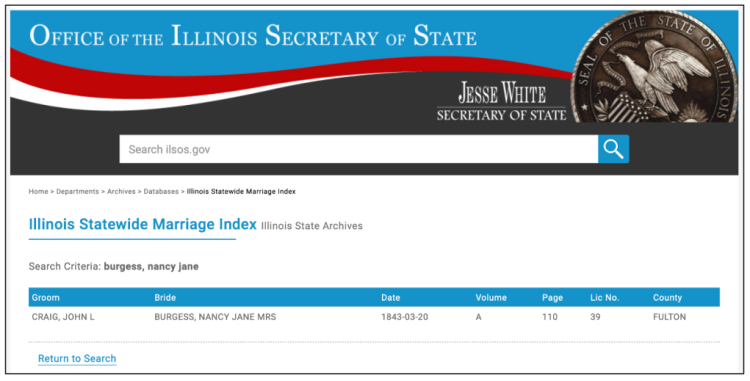Have you come across a derivative record transcribed from an original document? Ever wonder if it is worth the time, effort, and expense to obtain a copy of the original? The answer to the last question is a definite YES. Let me explain through a brief example.
When reviewing my autosomal DNA matches on Ancestry.com, I discovered a genetic network or cluster of matches showing great potential to help me break through a brick wall and go back another generation on my Wilson line. This cluster contained 24 matches who matched one another suggesting all descend from a common ancestor. Most matches in the cluster descended from two different ancestral couples who appeared to travel together in the early 1800s from the same places in Pennsylvania to the same places in Ohio. Adding to the intrigue, one person within each of the two couples was a Wilson. [Can you feel the excitement?!] However, there was another group of four matches within this larger cluster who appeared to descend from the union of John L. Craig and Nancy Jane Burgess, who were generally from the same time period and traveled the same migration route as the other two groups. But how do John and Nancy Jane fit into the genetic network?
To learn more about John L. Craig and Nancy Jane Burgess, I started by finding their marriage record, which I found in the Office of the Illinois Secretary of State’s online Illinois Statewide Marriage Index.1

The record was a derivative or a transcription and did not contain an image. Yet, I noticed something interesting. The record indicated Nancy Jane was a “Mrs” suggesting she might have been previously married. Could Nancy Jane have been born a Wilson? It seemed logical given the other Wilsons in the cluster.
I then expanded my search to Ancestry.com. I found the record here too, but again no image. Interestingly, this record included no mention of Mrs for Nancy Jane. Now, I was not only agitated by the lack of an image, but I was also now confused. Was she or wasn’t she previously married? Which record is correct?

The only way to reconcile the issue was to obtain an original copy, which I did by contacting the Illinois Regional Archive Depository at Western Illinois University. In an era where we only wait seconds for online images to load, ordering an original from a repository felt like an eternity. Yet, after several weeks and $17 (well worth the wait and cost), I received the following copy of the original.

In reviewing the original record, it becomes clearer where the confusion originated. The marriage license, which is in the upper portion of the record, states that Nancy Jane was a “Miss” suggesting she was a Burgess by birth. (“Miss” is written using the long s, or “Mifs” without the crossbar on the f, which is the old style of writing a double s.3) However, the recording of the completed marriage, which is in the lower portion of the record, appears to indicate that Nancy Jane was a “Mrs”.
While the original record doesn’t conclusively answer the question whether Nancy was a Miss or Mrs, it does explain why the online Illinois Statewide Marriage Index and Ancestry.com show conflicting information.
Professional genealogists often insist that researchers obtain original copies of records and not rely on transcripts. So, it’s worth repeating here again. Transcripts are made by people. People make mistakes. Had I relied solely on the online Illinois Statewide Marriage Index, I might have recorded Nancy Jane’s maiden name as unknown, and perhaps through confirmation bias, believed (or hoped) her maiden name was Wilson because of the genetic network to which she belonged among my autosomal DNA matches.
On the other hand, if I solely relied on Ancestry.com, I would have recorded Nancy Jane’s maiden name as Burgess. However, having access to the original record provided me with the necessary knowledge to interpret Nancy Jane’s marital status at the time of her marriage to John.
The moral of the story is that there is power in the original record. Spend the time, effort, and expense to locate it because it will ultimately save you time, effort, and expense in the end.
Spoiler Alert: Further research (and time) led me to identify Nancy Jane’s parents and confirm that she was a Burgess. The same research also has me believing that Nancy Jane’s mother might be a Wilson, but that’s a story for another blog.
Don’t miss new blog posts. Complete the form below to be notified every time I write a new blog.
Sources
1. Illinois Statewide Marriage Index, 1763-1900, John L. Craig and Mrs. Nancy Jane Burgess (20 March 1843), Fulton County, Illinois, Vol. A, p. 110, license number 39, database, Office of the Illinois Secretary of State (ilsos.gov, accessed 7 November 2020).
2. Illinois, U.S., Marriage Index, 1860-1920, John L. Craig and Nancy Jane Burgess, database, Ancestry (www.ancestry.com, accessed 5 December 2020); citing Illinois State Marriage Records, Illinois State Public Records Office.
3. Donal, A. (n.d.), “Reading Old Documents: The Long S,” Family Tree Magazine, accessed 9 January 2022 from https://www.familytreemagazine.com/strategies/reading-old-documents-the-long-s/.
3 thoughts on “The Power of Original Records”